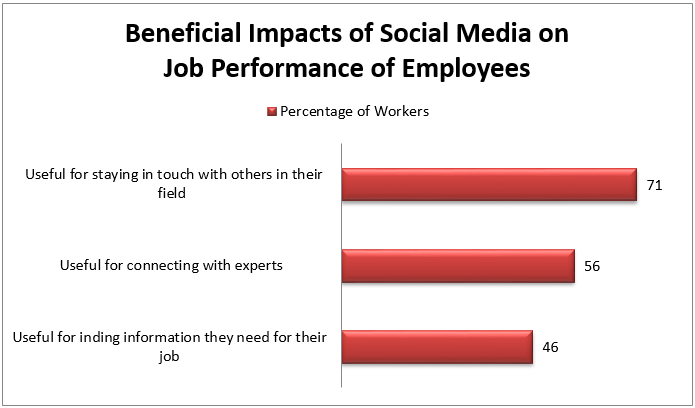5 Ways Social Media Can Enhance Your Online Training Strategy

The reasons to incorporate social media in your online training strategy should not be because others are doing it or because it’s trending. Instead, there are worthy reasons to use social media for online training or other learning opportunities. According to a study by Pew Research Centre:

And ultimately, 56% employees believe using social media helps enhance their job performance. So to say, using social media in online learning fosters effective learning, encourages more sociability among learners and raises engagement in your eLearning program.
Having said so, social media stands out as an effective and innovative learning method to be incorporated before and after formal training sessions. And if your organization is yet to incorporate social media tools in online learning, here’s a blog to help you get started.
Five Ways Social Media Can Enhance Online Training
- Creating awareness and fostering readiness
- Stimulating prior recall of knowledge
- Offering additional practice
- Refreshing and reinforcing knowledge
- Transferring knowledge to the workplace
Using Social Media Before Formal Training
1. Creating Awareness and Fostering Readiness
You know you are ready to rollout eLearning courses that will enhance your employee productivity. But the question is, do your learners feel the same? Well, launching a new online training is much like launching a new product in the market. Your marketing team promotes the product and get people talking about it.
Likewise, you can build excitement and buzz if you start marketing your upcoming online courses internally. This in turn helps create awareness about the training and fosters readiness to learn. Your employees will have ample time to get onboard and spread the word before the training is scheduled to start.
Here are some ways social media can help you create the much-needed buzz:
- You can create a group in social media platforms such as LinkedIn or Facebook. Learners can share their ideas, apprehensions, and doubts about the upcoming online training session.
- You can share content that explains the purpose and the learning objectives of the course. The content can be in the form of a micro video, a trailer, a podcast, animated infographics, and much more.
- You can post announcements about upcoming courses, including easy access links to videos and audio in YouTube. Learners can like, comment, and share their responses
- You can even use the “story” feature of platforms such as Instagram, Snapchat, and Facebook to highlight benefits of the course, key takeaways, screenshots of the course and so forth.
- Reminders and refreshers can be posted periodically to keep the excitement going.
2. Stimulating Prior Recall of Knowledge
Now that your learners are aware of the benefits of the eLearning course, it’s time to stimulate their prior learning. It’s helping learners make sense of the new information by relating it to something they already know. This allows them to comprehend new information much faster.
To enable this, you can present learners with a cue or an activity that stimulates their prior knowledge. And what better than making use of social media platforms your learners actively use. Here are some ways to use social media to stimulate prior recall of knowledge and gearing them for upcoming online training courses:
- Offer pre-assessment modules in social media sites for learners to evaluate their existing knowledge and build on it. Later, learners can post their queries and seek answers from those who know.
- Post or link specific blogs that quickly brush up information your learners must be acquainted with.
- You can incorporate multi-level quizzes using Facebook or Twitter poll service where learners are encouraged to use their existing knowledge.
- Invite learners for an online discussion on related knowledge they already have. Prompt them to recall, identify and share experiences.
These were some ideas on how social media can be quickly implemented in your online training strategy, before training. Now, let’s get to know what happens post training.
Using Social Media Post Formal Training
3. Offering Additional Practice
While your eLearning course will offer learners opportunities to practice the newly acquired knowledge, social media can take it a step further. This allows reemphasize comprehension while additional practice enhances greater retention.
Here are some ways to offer opportunities for additional practice:
- Creating engaging activities such as riddles, picture quizzes, scavenger hunts using social media sites. For instance, Facebook’s Scavenger Hunt application allows learners to apply their knowledge to gather all the required items to succeed.
- Sharing user-generated content such as videos, podcasts, and blogs with peers. This is another useful way to put knowledge into practice and share with those who are seeking solutions through online communities of practice or social media groups.
- Having learners participate in assignments on social media platforms. For instance, ask learners to create a story using Twittories or chained through their tweets.
4. Refreshing and Reinforcing Learning
No matter how engaging your eLearning courses are, your learners can’t escape the forgetting curve. Hence, it’s important to battle memory lapses and enhance retention by refreshing and reinforcing the acquired knowledge periodically.
And here’s how you can leverage social media platforms for the same:
- Post microlearning resources such as videos, interactive PDFs, infographics in your social media platforms. Since they convey one learning objective or idea comprehensively, learners get to-the point information, without having to sift through lengthy modules.
- Set up a course page or blog for learners and trainers to post comments to continue discussions on the course, share links to relevant resources, as well as reflect on how learners are applying their knowledge on job.
- The course page can be used to post reminders or summaries of what they learned in the training sessions. Reminders can also be about changes and updates.
5. Transferring Knowledge to the Workplace
To ensure practical success after your eLearning endeavor, it’s imperative your learners apply their acquired knowledge on job. Your training budget and time is wasted if your employees can’t transfer learning to their job. To avert this situation, you can use social media mediums.
Here are some ways:
- You can post profiles of Subject Matter Experts (SMEs), trainers, mentors, for ongoing support. They can promote learning resources and/or facilitate discussions whenever required.
- Learners can form an online community of practice to continue to share resources and support each other when in need.
- Learners and trainers can directly contact each other through social media messengers or tweets, without having to share phone numbers.
- You can post latest and interesting articles — such as best practices, tips on how to accomplish a task — to facilitate smooth knowledge transfer.
Wrapping it Up
In the end, good corporate use of social media will:
- Provide a better learning experience
- Result in better communication and collaboration
- Boost productivity
These were my insights on how social media can enhance the performance of your employees. Do you know of other ways how social media can help? Do share what you think!



![5 Ways to Use Social Media in Online Training [Infographic]](https://blog.commlabindia.com/hubfs/Imported_Blog_Media/social-media-online-training-infographic.jpg)

